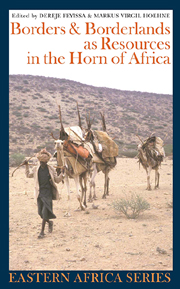Book contents
- Frontmatter
- Contents
- List of Maps, Tables & Charts
- Preface by Günther Schlee
- Editors' Preface
- Notes on Contributors
- List of Acronyms
- 1 State Borders & Borderlands as Resources
- 2 More State than the State?
- 3 Making Use of Kin beyond the International Border
- 4 The Tigrinnya-speakers across the Borders
- 5 Trans-Border Political Alliance in the Horn of Africa
- 6 People & Politics along & across the Somaliland-Puntland Border
- 7 The Ethiopian-British Somaliland Boundary
- 8 The Opportunistic Economies of the Kenya-Somali Borderland in Historical Perspective
- 9 Magendo & Survivalism
- 10 Can Boundaries not Border on One Another?
- 11 Conclusion
- Index
- EASTERN AFRICAN STUDIES
5 - Trans-Border Political Alliance in the Horn of Africa
The Case of the Afar-Issa Conflict
Published online by Cambridge University Press: 05 April 2013
- Frontmatter
- Contents
- List of Maps, Tables & Charts
- Preface by Günther Schlee
- Editors' Preface
- Notes on Contributors
- List of Acronyms
- 1 State Borders & Borderlands as Resources
- 2 More State than the State?
- 3 Making Use of Kin beyond the International Border
- 4 The Tigrinnya-speakers across the Borders
- 5 Trans-Border Political Alliance in the Horn of Africa
- 6 People & Politics along & across the Somaliland-Puntland Border
- 7 The Ethiopian-British Somaliland Boundary
- 8 The Opportunistic Economies of the Kenya-Somali Borderland in Historical Perspective
- 9 Magendo & Survivalism
- 10 Can Boundaries not Border on One Another?
- 11 Conclusion
- Index
- EASTERN AFRICAN STUDIES
Summary
Introduction
This chapter takes a look at the cross-border political alliance in relation to the long-standing conflict between the Issa-Somalis and the Afar along the Ethio-Djibouti border. It argues that Somali governments and the ideology of a ‘Greater Somalia’ helped the Issa in Djibouti and Ethiopia to dominate the Afar and expand into their territory. The Afar are marginal constituencies in the adjacent states where they live.
The Issa, a section of the Dir clan of the Somali, inhabit the coastal portion of the Awdal region of Somaliland, the southern part of the Republic of Djibouti and the Shinile Zone of the Somali National Regional State in the Federal Democratic Republic of Ethiopia. Around 300,000 Issas live in Djibouti. Another quarter of a million Issas are believed to reside in Somaliland. The land inhabited by the Issa-Somali incorporates border areas between Djibouti and the self-proclaimed state of Somaliland. It also stretches along the Ethio-Djibouti railway where the immediate neighbours of the Issa are the Afar (Lewis 1961: 71).
The Afar people have a distinct cultural and linguistic identity of their own and inhabit a well-defined territory in the African Horn, an area commonly referred to as the Afar Triangle, which is divided between Ethiopia, Eritrea and Djibouti (Abdallah 1993: 1). Afars are estimated to amount to 2.2 million in the three states they inhabit in the Horn, living along the main road that connects the centre of Ethiopia with the harbours of Assab and Djibouti. The main perennial river, the Awash, also traverses the land of the Afar.
- Type
- Chapter
- Information
- Publisher: Boydell & BrewerPrint publication year: 2010



